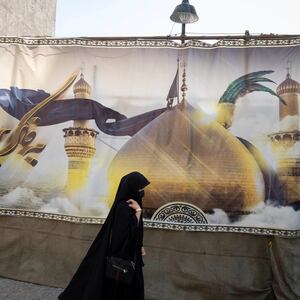A deadly wave of attacks recently claimed by the Islamic State (ISIS) in Afghanistan is sparking fears across intelligence communities worldwide that a familiar nightmare is re-emerging.
No doubt, the pattern is alarming: Ever since the suicide bombing that killed roughly 100 Afghans and 13 U.S. servicemembers on Aug. 26, the group has persisted with more mass-casualty attacks across the country, including a suicide bombing at the funeral for Taliban spokesman Zabihullah Mujahid’s mother, another suicide bombing against the Shi'a Hazara mosque in Kunduz, and a dual suicide attack on Shi’a Bibi Fatima mosque in Kandahar just a couple of weeks ago.
“We’re concerned that ISIS-K can take advantage of a significantly weakened security environment,” after the U.S. withdrawal, FBI Director Christopher Wray told lawmakers last month. In the same hearing, National Counterterrorism Center Director Christine Abizaid expressed worry that ISIS is “building off the notoriety it received” from the Kabul airport attack.
But is that really the case? Are these signs of a more emboldened, rejuvenated ISIS?
While on the surface, ISIS’s shift toward mass-casualty attacks, accompanied by a targeted anti-Taliban media campaign, can be seen as signals of confidence—it’s far more likely that the group is acting out of pure desperation. Both locally and globally, the Taliban’s takeover of Afghanistan threatens ISIS in profound new ways, and marks yet another major defeat from which ISIS will likely not recover.
ISIS’s Khorasan Province, also known as ISKP or ISIS-K, originated from the Taliban and allied groups in 2015. Its pitch to the radical jihadists of Afghanistan was easy to make in those days: With the U.S. still in Afghanistan, and with its “caliphate” then growing rapidly across the world, ISIS was the group that could finally change the course of the region.
It didn’t take long before the Taliban asserted its overwhelming dominance, though. Much like the Shabaab al-Mujahideen did to ISIS-pledged militants in Somalia, the Afghan Taliban steadily rooted out the vast majority of ISIS’s Khorasan Province. The former Afghan government and U.S. government put further pressure on ISIS in the years that followed, helping to cut its ranks from an estimated 3,000 to 300.
Now, with the Taliban in control of Afghanistan and the U.S. military gone, the ISIS sales pitch becomes a much harder sell: no “infidel” invasion of Muslim lands to rail against, and no significant ranks to resemble a “caliphate.”
Today, ISIS is instead reserved to cell-based terrorism and guerrilla warfare. Its unsophisticated attacks in the last year point to its limited capabilities: IED attacks, dismantling power lines, sniper attacks, and suicide operations. And with the Taliban now armed with scores of U.S. Humvees, armored fighting vehicles, and other major weaponry, it seems very implausible that ISIS will ever have a stable base in Afghanistan.
This new reality has required ISIS to reconfigure its pitch to Afghans. The Taliban, after all, has now established an “emirate” far more secure than the “caliphate” ISIS failed to hold onto. All that considered, ISIS may have even been better off with the U.S. in Afghanistan than it is now.
The group’s new media campaign has reframed its role from a Taliban rival to a righteous opposition force. ISIS and ISIS-aligned media groups are now punching up, referring to the Taliban as “the security guard for the interests of America” while declaring a “a new stage in their blessed jihad” in Afghanistan.
Then there’s ISIS’s new phase of mass-casualty operations. These attacks are not intended to sway the United States one way or another, because it knows war-weary America will not be coming back in the same capacity as before. Nor does ISIS expect that its suicide bombings will somehow increase its odds at facing the ever-powerful Taliban, which it stands no real chance of challenging.
What ISIS is doing with attacks like that at Kabul’s airport is exactly what it did when it publicly burned a Jordanian pilot alive or drowned prisoners in cages in Hollywood style productions: making sure that its name continues to occupy headlines.
For ISIS, staying relevant and staying existent are one and the same. And to survive under the Taliban, the group will go to any and all extremes to maintain relevance. The airport attack was just another effort to hijack the conversation.: Headlines, news shows, and social media veered away from the U.S. withdrawal and Taliban takeover, and instead focused once more on the threat of ISIS. The group’s deadly suicide operations against Shi’ites and other soft targets in Afghanistan since then have done the same—all without any significant numbers or resources.
The Taliban’s Afghanistan takeover had other global implications for ISIS as well, because it was a mutual victory for an even deeper-rooted ISIS rival: al Qaeda.
While ISIS took a fast path to the caliphate, al Qaeda, the group from which ISIS split, urged patience. This was among ISIS’s favorite places to jab at al Qaeda, arguing to the global jihadi movement that its longer-standing rival had lost its way since 9/11 and had become useless in pursuing true Islamic statehood.
But in the end, ISIS lost it all while al Qaeda is finally seeing its strategy and narrative vindicated. This creates a powerful narrative within the global jihadist community, which is driven in no small part by narratives of victory and uncompromising piety.
Here is al Qaeda’s most powerful and longstanding ally, the Taliban, having established an “Islamic Emirate” after defeating the world’s most powerful military. And here is al Qaeda—its bonds with the Taliban just as strong as ever—sharing in that historic victory with a guaranteed place to regroup and grow after enduring so many tribulations. Al Qaeda’s past losses or its leadership’s lack of charisma no longer hinder it, because it can boast that its long-preached steadfastness is paying off.
And meanwhile, here is ISIS: everything lost, its propaganda machine a shell of what it once was, and its methodology a demonstrable failure. A so-called “Islamic State” that is anything but.
ISIS is no longer the same group it was in the days of the 2015 Paris attacks and its sweeping “caliphate” across Iraq, Syria, and beyond. The group was once able to flaunt itself as a serious military force via propaganda of training camps and fighters parading through controlled territories in rows of weapons-mounted trucks. Not anymore.
Sure, it has built presences in regions like West Africa, but it no longer holds a substantial base in any Sunni-majority country. Its propaganda now shows meagerly constructed training camps, and poorly equipped fighters confined to hidden bases.
While the impact of ISIS losing territories like Mosul and Raqqa are immeasurable, the Taliban’s takeover of Afghanistan is its own unique nightmare for ISIS, even if only symbolically. It is the final nail in the coffin for the pretensions of statehood it had still been holding onto. Whether it keeps with the gimmick or not, they know, just as the global jihadi community knows, that there is no viable path back to sweeping territories anymore. Not in Afghanistan, not in Syria, not anywhere.









